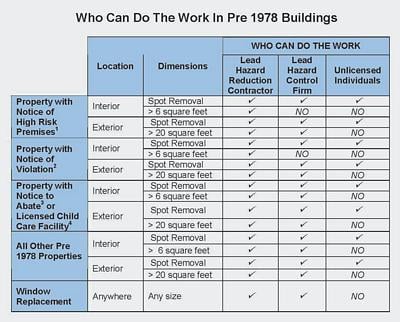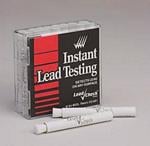EPA Announces More Lead Paint Violation Fines; This Time Against Landlords
Seems EPA has started their publicity campaign regarding enforcement of RRP and other lead related regulations. This one is not RRP specific, but as the second violation announcement this week it certainly seems to demonstrate that EPA is using enforcement and press releases to get their message out about compliance with lead paint requirements.
News Release
U.S. Environmental Protection Agency
New England Regional Office
April 11, 2012
Contact: Paula Ballentine, 617-918-1027
Conn. And Mass. Based Landlords Face Fines for Failing to Notify Tenants about Lead Paint
(Boston, Mass. – April 11, 2012) The owners of rental properties in Bridgeport, Conn. as well as South Boston, Roxbury, and Dorchester, Mass., face EPA penalties for violating federal lead paint disclosure rules. In both cases, these violations potentially put tenants at risk of exposure to lead hazards.
According to a complaint filed by EPA’s New England office, Juan Hernandez allegedly violated lead-based paint disclosure requirements seven times when he rented apartment units in Bridgeport, Conn. between 2008 and 2010. Mr. Hernandez faces an EPA penalty of up to $127,150 for violating federal lead paint disclosure rules. During the time period relevant to EPA’s investigation, all of the apartment buildings owned by Mr. Hernandez were located in potential environmental justice areas.
In a separate EPA complaint, Edward Franco, owner of El Paso Management, and its affiliates allegedly violated lead-based paint disclosure requirements when they rented apartment units three times in South Boston, Roxbury, and Dorchester in 2009. Most of the tenants involved in this case live in low income and/or minority areas.
Both parties are charged with failing to give tenants required lead hazard information pamphlets, failing to include lead warning statements in leases, failing to disclose any known lead-based paint or lead-based paint hazards, and/or failing to provide records or reports pertaining to lead-based paint or lead-based paint hazards.
Federal lead disclosure rules are meant to give tenants adequate information about the risks associated with lead paint so that they can make informed decisions before signing a lease contract. Property owners leasing housing built before 1978 are required to provide the following information to tenants: the EPA-approved lead hazard information pamphlet, Protect Your Family from Lead in Your Home; a lead warning statement; statements disclosing any known lead-based paint and/or lead-based paint hazards; and copies of all available records or reports regarding lead-based paint and lead-based paint hazards. This information must be provided to tenants before they enter into leases.
Infants and young children are especially vulnerable to lead paint exposure, which can cause developmental impairment, reading and learning disabilities, impaired hearing, reduced attention span, hyperactivity and behavioral problems. Adults with high lead levels can suffer difficulties during pregnancy, high blood pressure, nerve disorders, memory problems and muscle and joint pain.
More information:
Lead-based paint health hazards (www.epa.gov/ne/eco/ne_lead/index.html)
Lead-based paint disclosure rule (www.epa.gov/ne/enforcement/leadpaint/index.html)
Click here for more RRPedia blog posts for landlords.
Shawn is available to help landlords with the RRP Rule. If you are a landlord or belong to a landlord association that is seeking assistance with the RRP rule, contact Shawn today to discuss how he can help.

 Looking for accurate information about the EPA RRP rule?
Looking for accurate information about the EPA RRP rule? 
 Being a landlord brings with it many legal responsibilities related to lead paint that, if not followed, can certainly eat away at any potential profits. There are many rules to consider and be aware of, the most common being the
Being a landlord brings with it many legal responsibilities related to lead paint that, if not followed, can certainly eat away at any potential profits. There are many rules to consider and be aware of, the most common being the  When work is done inside their units, tenants must be given an EPA published pamphlet titled “Renovate Right”. The pamphlet explains the dangers of lead and what is required to protect their and their family’s health and safety when work is being done at the property where they live. If work is to be done in common areas, the pamphlet can either be given to tenants, or, notices can be posted telling tenants how they can receive the pamphlet at no cost to them. Tenants must also be given or made aware how they can request a document titled the
When work is done inside their units, tenants must be given an EPA published pamphlet titled “Renovate Right”. The pamphlet explains the dangers of lead and what is required to protect their and their family’s health and safety when work is being done at the property where they live. If work is to be done in common areas, the pamphlet can either be given to tenants, or, notices can be posted telling tenants how they can receive the pamphlet at no cost to them. Tenants must also be given or made aware how they can request a document titled the  If the landlord does his own work on the rental property and or uses his/her own employees to do so, the landlord must also become an EPA Certified RRP firm and only use trained and certified workers to do the work. If you are a landlord doing your own work,
If the landlord does his own work on the rental property and or uses his/her own employees to do so, the landlord must also become an EPA Certified RRP firm and only use trained and certified workers to do the work. If you are a landlord doing your own work,  NOTE: If you are a landlord, realtor or member of a group representing landlords or realtors seeking help and information about the RRP rules, feel free to
NOTE: If you are a landlord, realtor or member of a group representing landlords or realtors seeking help and information about the RRP rules, feel free to  Rhode Island has been operating a Lead-Safe Remodeler/Renovator Program since 2001 and has licensed over 1,500 Lead-Safe Remodeler/Renovators. In 2010, the Environmental Protection Agency (EPA) created its own Lead-Safe Remodeler/Renovator Program, known as the Lead-Based Paint Renovation, Repair, and Painting Rule. Rhode Island was the first New England state granted authority by EPA to continue its state Remodeler/Renovator program.
Rhode Island has been operating a Lead-Safe Remodeler/Renovator Program since 2001 and has licensed over 1,500 Lead-Safe Remodeler/Renovators. In 2010, the Environmental Protection Agency (EPA) created its own Lead-Safe Remodeler/Renovator Program, known as the Lead-Based Paint Renovation, Repair, and Painting Rule. Rhode Island was the first New England state granted authority by EPA to continue its state Remodeler/Renovator program.  Rhode Island's RRP Rule applies to contractors, landlords, property managers, homeowners, and anyone else who disturbs painted surfaces on pre-1978 homes or child care facilities. This includes general contractors as well as special trade contractors, such as painters, plumbers, carpenters, and electricians.
Rhode Island's RRP Rule applies to contractors, landlords, property managers, homeowners, and anyone else who disturbs painted surfaces on pre-1978 homes or child care facilities. This includes general contractors as well as special trade contractors, such as painters, plumbers, carpenters, and electricians.
 When work is complete, Lead-Safe Remodeler/Renovators and their workers must:
When work is complete, Lead-Safe Remodeler/Renovators and their workers must: Many contractors seeking to comply with the new EPA RRP rule are reporting concerns and challenges about finding trade partners who are willing to operate in compliance. Many renovators have told me that their trade partners have flat out refused to get their businesses and workers certified. Others have said their trade partners have committed to do so but have been slow to get it done due to the related costs. This has become quite an opportunity for some trade partners who have become certified and are marketing their certifications and services to general contractors. Several are actually offering to sub-contract the set-up, containment, demo, clean-up, cleaning verification and all related and required documentation for general contractors.
Many contractors seeking to comply with the new EPA RRP rule are reporting concerns and challenges about finding trade partners who are willing to operate in compliance. Many renovators have told me that their trade partners have flat out refused to get their businesses and workers certified. Others have said their trade partners have committed to do so but have been slow to get it done due to the related costs. This has become quite an opportunity for some trade partners who have become certified and are marketing their certifications and services to general contractors. Several are actually offering to sub-contract the set-up, containment, demo, clean-up, cleaning verification and all related and required documentation for general contractors. Who will take care of the notification requirements and documentation of same before the job begins? Under the rule, either can do so, but the business under contract with the property owner must maintain the required documentation.
Who will take care of the notification requirements and documentation of same before the job begins? Under the rule, either can do so, but the business under contract with the property owner must maintain the required documentation. The first time a RRP fine is accessed for a violation the finger pointing will start, causing one or both businesses to get serious about certification and compliance. The first time a renovator is sued by a client or neighbor as a result of the actions of a trade partner, the tactics used by the lawyers will cause both businesses to have a new and different outlook on RRP compliance, insurance coverage amounts and indemnification clauses.
The first time a RRP fine is accessed for a violation the finger pointing will start, causing one or both businesses to get serious about certification and compliance. The first time a renovator is sued by a client or neighbor as a result of the actions of a trade partner, the tactics used by the lawyers will cause both businesses to have a new and different outlook on RRP compliance, insurance coverage amounts and indemnification clauses.  To confuse matters even further, under their definition of the difference between an employee and an independent contractor, the IRS says that a contractor cannot supervise the work or workers of a sub contractor. Doing so might result in the IRS labeling the sub contractor as an employee. If this were to happen it could trigger addition payroll taxes and workers compensation costs for the general contractor.
To confuse matters even further, under their definition of the difference between an employee and an independent contractor, the IRS says that a contractor cannot supervise the work or workers of a sub contractor. Doing so might result in the IRS labeling the sub contractor as an employee. If this were to happen it could trigger addition payroll taxes and workers compensation costs for the general contractor. The U.S. Environmental Protection Agency recently filed a complaint and proposed a $784,380 penalty against Hanson’s Window and Construction Inc. of Madison Heights, Mich., for violations of the 1998 federal rule for failure to warn residents of potential lead-based paint exposures.
The U.S. Environmental Protection Agency recently filed a complaint and proposed a $784,380 penalty against Hanson’s Window and Construction Inc. of Madison Heights, Mich., for violations of the 1998 federal rule for failure to warn residents of potential lead-based paint exposures.
 Lead-based paint dust created during renovations is the most common source of lead exposure to children in the United States. About 75 percent of the nation’s housing built before 1978 contains lead-based paint. When properly managed, lead-based paint poses little risk. If paint is not maintained, however, even low levels of lead exposure can threaten occupants’ health, especially children and pregnant women
Lead-based paint dust created during renovations is the most common source of lead exposure to children in the United States. About 75 percent of the nation’s housing built before 1978 contains lead-based paint. When properly managed, lead-based paint poses little risk. If paint is not maintained, however, even low levels of lead exposure can threaten occupants’ health, especially children and pregnant women Recognized test kit means a commercially available kit recognized by EPA under Sec. 745.88 as being capable of allowing a user to determine the presence of lead at levels equal to or in excess of 1.0 milligrams per square centimeter, or more than 0.5% lead by weight, in a paint chip, paint powder, or painted surface.
Recognized test kit means a commercially available kit recognized by EPA under Sec. 745.88 as being capable of allowing a user to determine the presence of lead at levels equal to or in excess of 1.0 milligrams per square centimeter, or more than 0.5% lead by weight, in a paint chip, paint powder, or painted surface. 
 EPA recognizes that, when used by trained professionals, the
EPA recognizes that, when used by trained professionals, the  According to the EPA web site:
According to the EPA web site:


